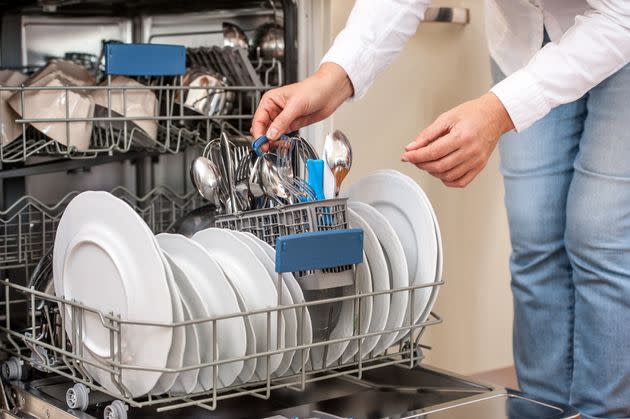Uh-Oh. You're Probably Loading Your Dishwasher All Wrong.

For many of us, loading the dishwasher isn’t just a household chore, it’s a minefield of opportunities to drive the people we love absolutely bonkers by where we choose to put our dirty bowls, how we insert our spoons, and how much gunk we leave on the lasagna pan.
“It really impacts people’s relationships,” Carolyn Forté, executive director of the Good Housekeeping Institute’s Home Care and Cleaning Lab, recently told us — Raj Punjabi and Noah Michelson, the hosts of HuffPost’s “Am I Doing It Wrong?” podcast — when she dropped by our studio.
“If you’re the type of person that wants to control the dishwasher and how it’s loaded, and your partner isn’t that fastidious, that can be a real bone of contention between couples or partners or whoever — even parents and kids,” she said. “People are very passionate about it.”
That’s why we asked her to share the dishwashing secrets she’s learned during her 40-plus years working in Good Housekeeping’s illustrious test labs — and she did not disappoint.
Listen to the full episode here:
“The biggest thing to think about when you’re loading the dishwasher is if the water’s not gonna hit it, it’s not going to get clean,” Forté said. “So you just have to make sure that the water has access to everything in there. If you’ve got bowls on top of each other — not good.”
Using all of the adjustable components in our dishwashers means we can take advantage of the space and ensure everything is sitting snuggly and will be hit by the machine’s water jets.
“Use the racks. Most dishwashers today have flexible tines that bend up and down, or fold up and down, so you can put bowls down or you can put them up if you’ve got small bowls,” Forté explained. “There are cup shelves that fold up or down to double tier, and [can give] you a double tier in the top rack. It’s all to expand and give you more flexibility when it comes to loading. Just think, ‘Is the water going to hit this?’ And if it is, then you’re good.”
The biggest mistake Forté sees people making is the way they’re loading their glasses.
“Glasses should go not over the tines in the top rack, but against them,” she advised. “So don’t put a glass over, let’s say, two tines. You feel like [putting it over the tines helps it] stand upright, but it could damage the glass, depending on how tight the fit is.”
Forté and most manufacturers recommend that our glasses rest against the tines not only so that they won’t break, but for another very smart reason.
“[If you load them against the tines, the glasses are] usually at an angle, so the water [automatically] runs off,” she said, which prevents those annoying water spots.
“Sometimes you have a cup that has a little base on it and you end up with puddling in there [if you haven’t loaded the glass correctly],” she said. “If it’s a shallow base, usually that’s not a problem, but sometimes it’s a pretty hefty base and you get a puddle of water. If you think that’s happening, make sure you unload the bottom rack first. That way when you pull the top rack out, the water doesn’t go down all over everything.”
Another supremely contentious dishwashing debate involves how to load cutlery.
“Years ago, you’d just have a basket in the bottom rack with all the different sections, and that’s really where most of the confusion came from — up? Down? Whatever,” Forté said. “A lot of dishwashers today have that top tier, so that’s a flat rack that you can put your flatware in just one at a time and line them up. It’s not as important if you put your flatware up there — how you put it in — because they’re all just laying down, and they’re all going to get clean.”
However, if your machine has a basket in the bottom rack, as many of our dishwashers do, there is an optimal way to load your silverware according to the research Forté’s team has conducted.
“We recommend that you put the knives point or blade down,” she told us. “Spoons should alternate up and down, because you don’t want two spoons to nest. If two spoons nest each other, then one’s not gonna get any [water or cleanser].”
Forks should go into the basket with their tines up, but Forté emphasized that we should grab them by the handle when we unload our clean dishes because our hands usually aren’t sanitized, and we don’t want to dirty our freshly disinfected pieces.
You can also separate all of your forks, knives and spoons into groups in the basket. That way you can easily grab bunches of the same kind of silverware and save time when you’re placing them back in your cutlery drawer.
Forté had tons of other great tips, including what she would never put in the dishwasher, her foolproof secret for removing burnt-on food from pans, and much more, so listen to the full episode above or wherever you get your podcasts.
Make sure to subscribe to “Am I Doing It Wrong?” so you don’t miss a single episode, including our investigations of the ins and outs of tipping, how to apologize or vanquish your credit card debt, how to find love online or overcome anxiety, tips for online shopping, taking care of your teeth and pooping like a pro, secrets to booking and staying in a hotel, how to deal with an angry person, cooking tips from celebrity chef Jet Tila, shocking laundry secrets, how to protect your online privacy, and more.
Need some help with something you’ve been doing wrong? Email us at AmIDoingItWrong@HuffPost.com, and we might investigate the topic in an upcoming episode.

